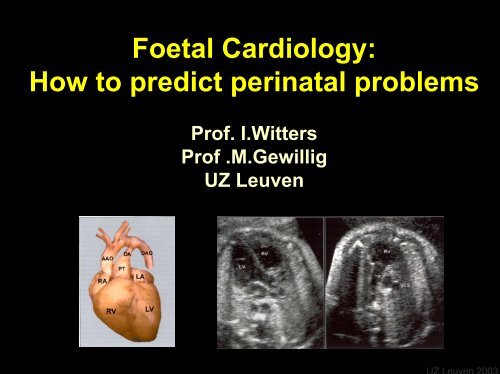Foetal Cardiology: How to predict perinatal problems - UZ Leuven
Foetal Cardiology: How to predict perinatal problems - UZ Leuven
Foetal Cardiology: How to predict perinatal problems - UZ Leuven
- No tags were found...
Create successful ePaper yourself
Turn your PDF publications into a flip-book with our unique Google optimized e-Paper software.
CardiopathiesIncidence : 8-12 / 1000 births ( 1% )Most frequent - Ventricle Septum Defect 20%- Atrium Septum Defect 9%- Patent Ductus Arteriosusimpossible Prenatal DiagnosisPrenatal detection of heart defects: 30-60%tertiary centers: 80%Hoffman, Incidence of cong.heart disease, Pediatr.<strong>Cardiology</strong>,1995,jul 16(4)155-165
<strong>Foetal</strong> heart : parallel circuitCommunications• Atrial : foramen ovale• Arterial:ductusarteriosus
Prenatal cardiac <strong>predict</strong>ion: limitations• Can be reliably described:- Cardiac ana<strong>to</strong>my and function• Difficult <strong>to</strong> describe:– septum defects– Predict adequate flow if PS– Predict adequate flow if AS – small isthmus– Predict size of isthmus after ductal closure• Cannot be <strong>predict</strong>ed:– Competence of atrial flap valve after birth– Extension of ductal constriction <strong>to</strong> Ao or Le PA
Courtesy:’Fetal <strong>Cardiology</strong>’;S.Nagel,NH.Silverman,U.GembruchCardiac Ana<strong>to</strong>my1.four-chamber view2.outflow-tracts3.three-vessel-trachea view
Normal cardiac ana<strong>to</strong>my
<strong>Foetal</strong> heart: asymmetric growthNormal heartClassical HLHS
HLHS: neonatal management• Norwood sequens– Norwood type operation < 14 d– Glenn shunt 6 - 12 m– Fontan TCPC 2 – 5 y– (HTX) .. ?• Neonatal HTX• Sedare et consolare
Possible flow restrictions <strong>to</strong> the left heartDilated sinus coronariuswith left VCSRestrictive foramen ovale
Asymmetric 4 chamber 19 w PMApersistent left VCS
Asymmetric 4 chamber : postnatal
Aortic arch : growth patternsNormalAo/AP ≈ 0,9? preductal coarctationAo/AP < 0,5
Cardiac <strong>problems</strong> : timing - localisation• Labour room– Activation of lung circuit– Closure atrial flap valve (complete < 3%)sec - min• D 1- 5 : Maternity– Closure arterial duct• > D 6 : Home– Drop pulmonary vascular resistancehours – daysweeks
Cardiopulmonary <strong>problems</strong> in labour room:Inadequate oxygenation• Lung pathology– Hypoplasia, hernia, pneumothorax• Severe heart dysfunction : hydrops• Inadequate pulmonary arterial perfusion– Hypoplasia vessels– Extreme pulmonary hypertension• Prenatal constriction arterial duct• Abnormal pulmonary venous return– TAPVU with obstruction ( Right atrial isomerism )– Pulmonary vein PV stenosis• Restrictive flow pulmonary blood <strong>to</strong> aorta– Intact atrial septum & TGA– Intact atrial septum & HLHS – severe MS
Prenatal <strong>predict</strong>ionSmooth stay in labour room• Normal appearence of lungs• No hydrops• Adequate PA• Normal PV <strong>to</strong> LA• unrestrictive flow PV <strong>to</strong> Aorta
Smooth stay in labour room:Unrestrictive flow PV <strong>to</strong> AortanormalUVH, TA, TAPVU, TGA
Inadequate oxygenation in labour roomComplete closure atrial flap valveintact atrial septum IAS (< 3%)HLHSTGA
Transposition Great Arteries
TGA survival : f° of shunt
TGA : management• ( Umbilical catheter through flap valve 1-3% )• Prostaglandin IV• ( Rashkind balloon sep<strong>to</strong>s<strong>to</strong>my )• Arterial switch ( † < 3%)
Rashkind balloon sep<strong>to</strong>s<strong>to</strong>my
Cardiopathies with <strong>problems</strong> after ductal closureLeft heart <strong>problems</strong>• HLHS• coarctation aortae/interrupted aortic arch• Critical ASRight heart <strong>problems</strong>• Pulmonary valve atresia / critical PSIsolated or complex (Tetralogy of Fallot, univentr. heart)• Transposition of the great arteries
Smooth stay in maternity:adequate flow PA & Aorta after ductal constrictionSmall istmusCoarctationHypoplastic archNormalMild subPS - PSSevere subPS - PSAtresia MAPCA’s
Critical AS with Mitral valve regurgitation
Balloon dilatation neonatal critical ASLV end dias<strong>to</strong>licLV end syss<strong>to</strong>lic
BD neonatal critical ASCut-off pigtail in LA ; 0.018" Terumo wire through MiV > apex> AoV > femoral artery ; fix in gro
BD neonatal critical AS5 mm Tyshack balloon over 0.018" Terumo wire
Critical PS with Tricuspid regurgitation
PA-IVS : fulguration PuVPremature, 2600 g; PA – IVS , hypoplastic & suprasystemic RV 120 mmHg, TS
5F Ri coronary JudkinsFulguration PuV
Fulguration PuV0.014 Standard wire in Desc Ao3.0 mm coronary balloon Viva 20 Bos<strong>to</strong>n Scientific (over wire or through 5F guiding Ri coronary)
Fulguration & BD PuV6 mm Tyshack balloon; residual waiste at level annulus
RV post Fulguration & BD PuV
Technique : schemaBA
Critical PS – IVS : stenting PDA3 mm / 20 mm stent in 2600g premature neonate
Isolated “agenesis” Pulmonary valve 28w
Isolated “agenesis” Pulmonary valve 35 w
Isolated “agenesis” PuV 37 w neonate
Isolated “agenesis” PuV 37 w neonate
Tetralogy of Fallot,16 weeks PMA
septal defectsmuscular VSD
AV-canal AVSD30% trisomy 21
RA tumor 35 w PMA
RA tumor 38 w PMA
RA tumor: tamponnade• Urgent deliver : sectio• Simultaneously:– Intubation– Pericardial drain– IV line– Umbilical catheter: fluid replacement• Diagnostics– Echocardiogram–MR
RA tumor: CXR
RA haemangioma
MRI: tissue characterising : haemangioma
• AdvantagesPrenatal diagnosis : impact– Plan adequate help in labour room– Maintain optimal cardio-respira<strong>to</strong>ry condition• No excessive cyanosis• No circula<strong>to</strong>ry shock– Adequate counseling & guidance of family• Disadvantages– Difficult diagnoses (septal defects / open ductus / coarctation)– Late appearance of some heart <strong>problems</strong> (tumors /valve stenoses)– No test of duct dependency
















